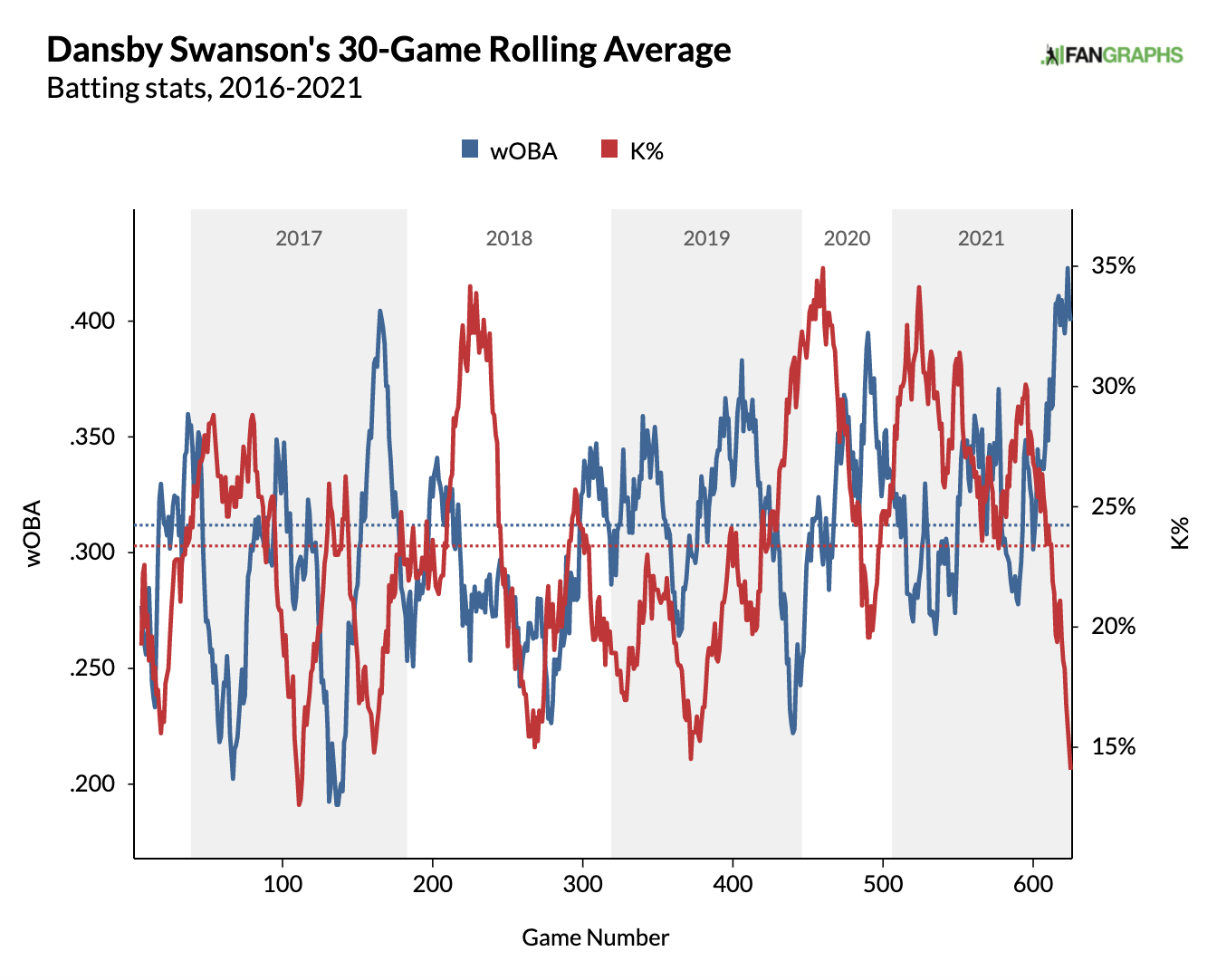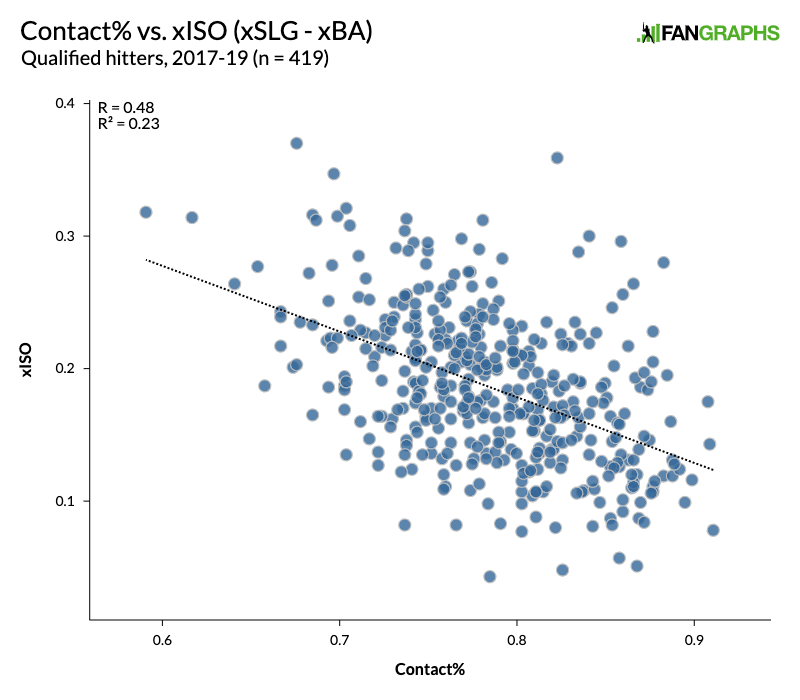How Dansby Swanson Increased Contact Without Sacrificing Power
As the Braves have moved up the standings, claiming sole possession of first place in the NL East for the first time this season, the left side of their infield has lead the charge. Granted, the whole team is playing well right now, but through August 16, third baseman Austin Riley and shortstop Dansby Swanson are each in the top-10 in WAR since the All-Star break, at 1.5 apiece.
I wrote about Riley earlier this season, so it makes sense to cover his left-side counterpart now. Plus, Swanson has always been a personal favorite of mine; in January 2020, I wrote about why I thought he was poised to break out ahead of last season. And while Swanson’s offensive numbers — he posted a .274/.345/.464 slash line and a 116 wRC+ — were the best of his career, critics could still point to a raised strikeout rate, high BABIP, and general lack of power. At the time, I said that Swanson’s improved plate discipline might be one sign of better days to come. But with the significant increase in strikeouts and no associated increase in power, it seemed fair to worry about what he’d do at the plate in 2021.
The projection systems were ambivalent on the sustainability of his 2020 as well. ZiPS had Swanson posting a 90 wRC+ this year; Steamer, slightly more optimistic, went with 93. His 2021 stats don’t deviate that much from those projections either: Through 495 plate appearances, he’s slashed .264/.316/.493 with a 110 wRC+ — better than the start of his career, but worse than 2020.
The power, though, has showed up, as Swanson has set a new career high in homers (and by a wide margin) with 24. Going into this year, he had homered in just 2.4% of plate appearances; that rate has now doubled. But perhaps the most amazing thing is what he’s done since the All-Star break, which really deviates from some most prominent fundamental truths in baseball if sustained.
In the second half, Swanson is hitting .320/.353/.600 with a 149 wRC+ and has homered nine times in 133 plate appearances. But most incredibly, he has cut his strikeout rate in half, going from a 28% rate in the first half to just 14% since. In case you were wondering what that looks like, here’s his 30-game rolling wOBA and strikeout rate. While he had a similar stretch in 2017, this current span has both a higher wOBA and a lower strikeout rate than that one:

Swanson is striking out less and performing better. That’s good, but it’s not necessarily good for all types of hitter. Striking out less usually means that you’re making more contact, and as you can probably tell based on where I’m going with this, more contact isn’t always better. It might be better for contact-only hitters like David Fletcher or Nick Madrigal, but for more well-rounded players, especially those with above-average power, more contact probably means worse quality of contact. And for Swanson, higher contact rates certainly drive lower strikeout rates. Here’s a plot of every 30-game stretch of his career, showing his contact rate and his strikeout rate in those stretches:

For Swanson, more contact has meant fewer strikeouts, and in the second half, he’s making contact on nearly 80% of swings. As you could probably guess by the magnitude of his strikeout rate decrease, he has one of the largest increases in contact rate from the first half to the second:
| Player | Contact%, 1H | Contact%, 2H | Difference |
|---|---|---|---|
| Michael A. Taylor | 62.1% | 74.9% | 0.128 |
| James McCann | 69.0% | 80.0% | 0.110 |
| Dansby Swanson | 69.0% | 79.5% | 0.105 |
| Nick Ahmed | 69.7% | 79.3% | 0.096 |
| Rowdy Tellez | 74.9% | 84.1% | 0.092 |
| Odúbel Herrera | 77.0% | 85.2% | 0.082 |
| Josh Harrison | 79.8% | 87.7% | 0.079 |
| Jackie Bradley Jr. | 65.8% | 73.6% | 0.078 |
| Miguel Cabrera | 72.0% | 79.7% | 0.077 |
| Randy Arozarena | 65.5% | 72.9% | 0.074 |
But where does the power come into play here? Swanson has not only had one of the largest increases in contact rate, but he’s also done this while increasing his ISO by 70 points and his xISO by 16, even as conventional wisdom would suggest a decrease in both. As you can see below, Swanson is a bit of an extreme, though other hitters have also increased both their contact rates and xISO from the first to the second half:

I’m using xISO here as opposed to ISO because the former eliminates some of the luck and ballpark factors associated with the latter, but this still doesn’t tell us if Swanson’s performance is necessarily sustainable. We’re dealing with small samples, and he could be going through a hot streak where he’s benefitting from significant luck regardless.
It’s hard to make much from an 100-odd plate appearance sample, but as you can see over larger sample sizes, hitters who make more contact tend to make less high-quality contact. Using a simple linear model evaluating qualified hitters from 2017 to ’19, we find that a 1% increase in contact rate is associated with a five-point reduction in xISO. There’s certainly a correlation here, with an R of 0.48:

What this also suggests, though, is that for Swanson, a 10-point increase in contact rate — over a full, qualified season’s worth of plate appearances, mind you — would come with a near 50-point decrease in xISO. Instead, he’s seen an uptick in contact rate worth 10 points and an associated xISO increase of 16 points, from .214 in the first half to .230 in the second.
As you can tell by looking at the last two graphs in juxtaposition to one another, sample size plays an enormous role here. Differences are smoothed out over a full season, where survivorship bias takes over and other sampling issues work themselves out. So while Swanson is currently making more contact without sacrificing power, it’s hard to think that this is something that will stick over a larger sample size.
But even with an ISO that comes back to Earth, maybe this is more of the type of player that Dansby Swanson should be. His expected stats in the second half — a .291 xBA and a .521 xSLG, compared to a .248 xBA and a .462 xSLG in the first — suggest that putting more balls in play would benefit him. Even though it seems unlikely that he will keep hitting for this much power, a more contact-centric approach might just be what he needs to establish himself as more of a threat at the plate.
Devan Fink is a Contributor at FanGraphs. You can follow him on Twitter @DevanFink.

Swanson has performed well on batted ball metrics for a while now. His xStats have been high since 2019. Nice to see it all coming together. I think something that has hurt him in the past has been perception and expectation. People saw him as a top of the order, high average guy. When in reality he’s best suited as a 5 or 6 hole run producer.